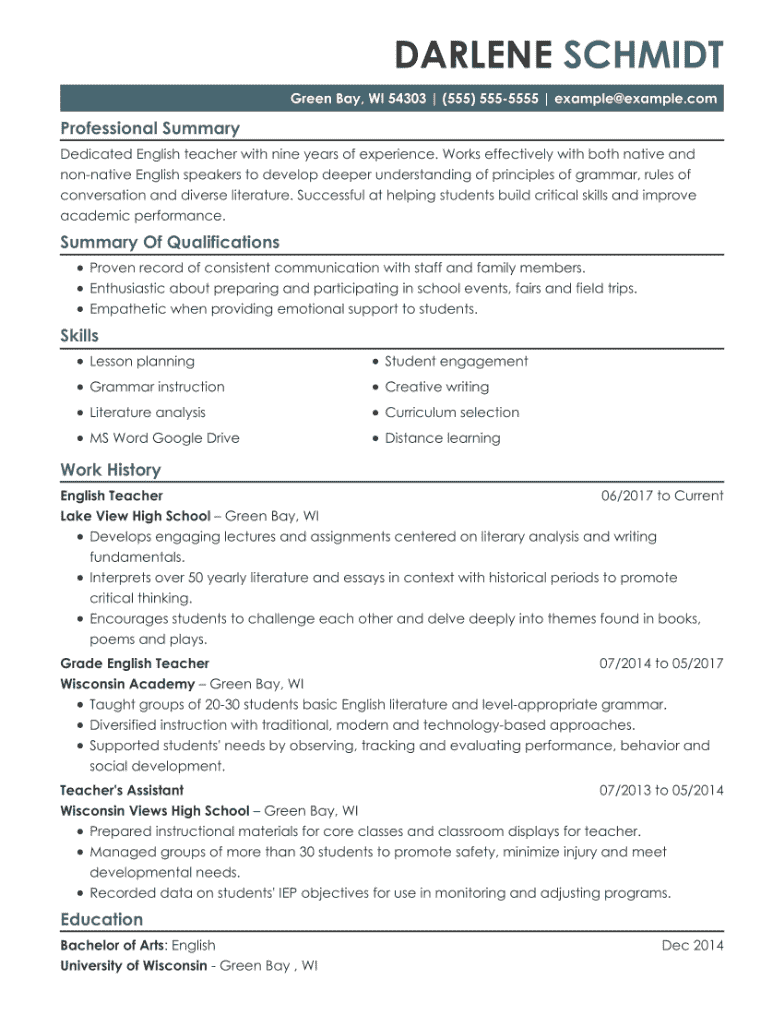We personalize your experience.
We use cookies in our website to ensure we give you the best experience, get to know our users and deliver better marketing. For this purpose, we may share the information collected with third parties. By clicking “Allow cookies” you give us your consent to use all cookies. If you prefer to manage your cookies click on the “Manage cookies” link below.
To get hired as a teacher, you need to have an impressive resume. To make sure your education resume shines, use these tips and examples.
Our customers have been hired by*:*Foot Note

Use this education resume example as a foundation for your own, following its structure and organization.

Education is a deeply important part of society, and if you’re interested in becoming part of the world of education, you’ll go through the process of learning how to teach. However, even with years of experience and plenty of resume skills, you still need to show off your knowledge in a way that makes an impact on a hiring manager. Here’s what you need to know about creating an education resume.
There are many, many jobs that can fall under the umbrella of education. Here are a few of them:
Your education resume might target a span from childhood education all the way to college level professor. However, the way you put your education resume together will be similar regardless of what type of teaching position you are applying to.
Create your resumeHow should you format your resume? Because education is such knowledge and experience-heavy field, your resume format will typically be a chronological resume. Here are the five sections you’ll typically use to organize your resume.
Here, you’ll write a 2-3 sentence paragraph with information about your best skills and key achievements. This is where recruiters look first, so you need to grab their attention and keep them reading.
Next is your experience section. If you already have work experience as a teacher, you can include it here. Include any teaching experience you have, including entry-level experience, internships, and even teaching positions if the job title isn’t exactly the same. For example, if you’re currently teaching science, but you’ve previously taught English, you can include that on your resume. Add your previous jobs in reverse-chronological order, with the most recent job experience first.
The resume skills section on a teacher resume should target the requirements of the specific job you want. Here are a few bullet points to get you started:
If you’re not sure what you want to use in your skills section, you can find education resume samples in the resume examples section at ResumeHelp for inspiration.
In order to teach, you typically will need a college degree, and you will add this information in this section. Typically, you should lead off by listing your top credential (e.g., your college degree). You don’t need to include your GPA, but you should add any honors you’ve received, like cum laude.
Lastly, if you have achievements and certifications, you can include them on your resume. You can create your own section if you want to make it even easier to scan these achievements.
Match your skills in your resume to the job listing using resume keywords related to skills and requirements that are present in the job description. It’s also important that your resume and cover letter complement each other in content and layout. You can use the ResumeHelp resume builder to find resume templates and education resume examples you can use for your next job application.
Create your resumeHave questions? We’re here to help.
It’s always a good idea to submit a cover letter with your resume. The cover letter can give you another opportunity to explain why you’re the best person for the job. Use the ResumeHelp cover letter builder to create a cover letter for your application, and look at our cover letter examples to help you create a cover letter that makes sense for you.
You can get an education job without specific experience teaching. If you’re looking for your first-ever teaching job, you’re going to rely heavily on your education and skills, using a functional format for your resume. You can also list academic experience, internships, and volunteering work when you’re listing your experience. These things all count as relevant experience, even if you weren’t getting paid.
Yes. You should always ensure that your education resume has all the right skills to reflect what the hiring manager wants to see. Even just taking a few extra minutes to tailor your resume can help significantly in getting that all-important job interview. Look into resume keywords in the job posting so you can change your education resume in the way that a hiring manager really wants to see.
Couldn't find the answer you're looking for?